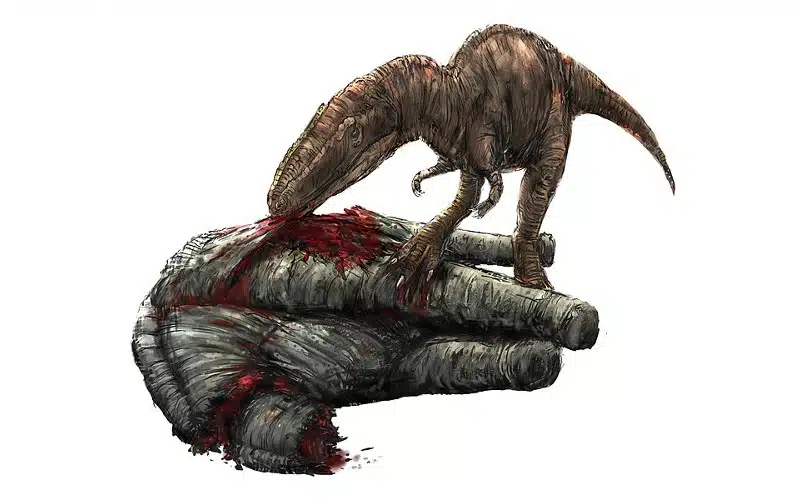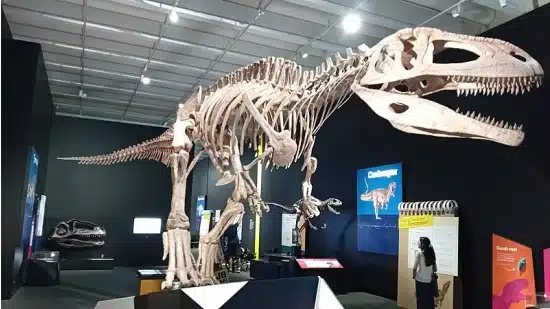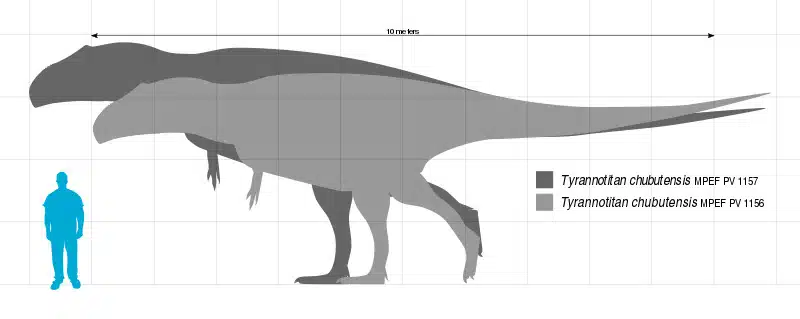Let’s embark on a journey back in time, ,
The formidable Tyrannotitan was a true giant among dinosaurs. Its name, meaning “Tyrant Titan,” gives us a hint of its imposing presence. Discovered in the rugged terrains of Argentina, this Theropod dinosaur has captivated the imagination of paleontologists and enthusiasts alike. It lived a little over one hundre million years ago, during the Early Cretaceous Period.
Tyrannotitan Key Facts
| Keyword | Fact |
|---|---|
| Pronunciation | tie-RAN-oh-tie-tan |
| Meaning of name | Tyrant Titan |
| Group | Theropod |
| Type Species | Tyrannotitan chubutensis |
| Diet | Carnivore |
| When it Lived | 113.0 to 100.5 MYA |
| Period | Early Cretaceous |
| Epoch | Albian |
| Length | 40.0 to 43.0 feet |
| Height | Around 14.0 feet |
| Weight | 4.8 to 7.0 tons |
| Mobility | Moved on two legs |
| First Discovery | Discovered at an unknown date by a team led by L. Guerrero, P. Puerta and R, Vacca |
| Location of first find | Chubut Province, Argentina |
| First Described by | 2005 by Fernando Novas, Silvina de Valais, Pat Vickers-Rich and Tom Rich |
| Holotype | MPEF-PV 1156 |
Tyrannotitan Origins, Taxonomy and Timeline
The name Tyrannotitan, blending Latin words for “tyrant” (tyrannus) and “giant” (titan), aptly describes this behemoth. Its etymology reflects the awe it inspires, akin to the infamous Tyrannosaurus rex. However, this dinosaur belongs to a different family, the Carcharodontosauridae, within the broader group of Theropod dinosaurs. This classification places it among some of the most fearsome predators of the dinosaur world.

As a member of the carcharodontosaurid family, this giant shares characteristics with other large theropods but stands out with unique features on its teeth (bilobated denticules on the mesial crainae), dentary bone (symphyseal margin in lateral view) and postcranial skeleton. Its genus, Tyrannotitan, and the type species, Tyrannotitan chubutensis, further define its distinct identity within the dinosaur kingdom
The timeline of this giant carnivore is fascinating. It thrived during the Early Cretaceous Period, specifically in the Albian Epoch, which spanned from 113.0 to 100.5 million years ago. This era was a time of significant change and diversification in the dinosaur world, and Tyrannotitan was a formidable part of that dynamic ecosystem.
Listen to Pronunciation
Discovery & Fossil Evidence
The discovery of Tyrannotitan in 2005 by Tom Rich, Fernando Novas, Pat Vickers- Rich and Silvina de Valais in Chubut Province, Argentina, marked a significant moment in paleontology. The holotype, MPEF-PV 1156, consisted of various bones, including parts of the jaw and limbs, providing a foundational understanding of this species.

Subsequent excavations in the same region yielded additional fossils, including vertebrae and limb bones. These finds helped clarify aspects of Tyrannotitan’s structure and potential movement. Despite the limited number of finds, each piece has been valuable in piecing together the life and environment of this ancient predator.
Tyrannotitan Size and Description
Let’s delve into the physicality of this prehistoric titan. Based on the fossil evidence we currently have, we can paint a picture of its formidable stature.
Short description of Tyrannotitan
Tyrannotitan’s physique was built for predation. Its robust body, supported by powerful hind limbs, suggests it was a bipedal hunter. The structure of its head, neck, and vertebrae indicate strength and agility, essential for a top predator. Its tail likely provided balance, while the condition of its skin remains a subject of speculation.
Size and Weight of Type Species

Tyrannotitan was a large animal, reaching an impressive 40.0 to 43.0 feet in length and 4.8 to 7.0 tons in body mass. These dimensions place it among the larger theropods, showcasing its imposing presence and suggesting it was an efficient hunter, capable of taking down large prey with ease.
The Dinosaur in Detail
Tyrannotitan’s unique features set it apart from its contemporaries. Its skeletal structure, particularly its skull and teeth, suggests a powerful bite, crucial for a carnivorous lifestyle. The arrangement of its limbs indicates a formidable speed for its size, making it an efficient hunter. Notable specimens have shed light on its growth patterns and possible behaviors, contributing to a richer understanding of this species.
Contemporary Dinosaurs
In the world of the Early Cretaceous, the formidable Tyrannotitan roamed with a commanding presence. This colossal predator, with its razor-sharp teeth and powerful limbs, was a force to be reckoned with. Among its contemporaries, the gentle giant Patagotitan lumbered across the landscape. This behemoth, significantly larger than the Tyrannotitan, was like a moving mountain, yet it lived a peaceful life, grazing on the abundant vegetation. Their interactions, though rare, were a study in contrasts: the agile predator and the serene titan, coexisting in a delicate balance.
Genyodectes serus, a Ceratosaur Theropod, was found in the same geological member (Cerro Castaño member of the Cerro Barcino Formation), and occupying a similar ecological niche. Competition between Tyrannotitan and Genyodectes might have occurred.
Nearby, the armored Agustinia, smaller than Tyrannotitan but no less impressive, navigated the terrain. Its spiky armor was a formidable deterrent, even for a predator as mighty as Tyrannotitan. These two might have had tense encounters, Tyrannotitan eyeing a potential meal, while Agustinia stood its ground, a prickly fortress on legs. Their interactions were likely a dance of power and defense, a testament to the survival instincts ingrained in these ancient creatures.
Not far off, Chubutisaurus, roughly the same size as Tyrannotitan, roamed. This herbivore, though not as large as the massive Patagotitan, still presented a challenge for any predator. Tyrannotitan, ever the opportunist, might have seen Chubutisaurus as potential prey. However, the size and strength of Chubutisaurus meant that any attack would be a calculated risk, a dramatic clash of titans under the ancient sun.
In this Cretaceous world, Tyrannotitan was a central figure, a testament to the raw power and complexity of nature. Its interactions with Patagotitan, Agustinia, and Chubutisaurus painted a vivid picture of life millions of years ago. It was a dance of survival, coexistence, and the eternal struggle for dominance.
Interesting Points about Tyrannotitan
- Described in 2005, Tyrannotitan is a relatively recent addition to the dinosaur roster.
- Its name, meaning “Tyrant Titan,” reflects both its size and presumed dominance.
- As a Carcharodontosauridae, it shares characteristics with other large theropods but has distinct features.
- Its fossils were found in Argentina in the Cerro Barcino Formation, adding to the rich dinosaur history of South America.
- Despite limited finds, each discovery has significantly enhanced our understanding of this species.
Tyrannotitan in its Natural Habitat
Imagine the world of Tyrannotitan, a landscape teeming with life and diversity. This giant predator inhabited a realm where lush vegetation likely flourished, supported by a climate that fostered a rich ecosystem. As a carnivore, Tyrannotitan was possibly at the top of the food chain, preying on other dinosaurs and shaping the dynamics of its environment.
Tyrannotitan’s locomotion, primarily on two legs, suggests it was an active hunter, possibly engaging in complex predator-prey relationships. Its diet likely consisted of large herbivorous dinosaurs, and its hunting strategies would have been a spectacle of nature’s raw power. Social behavior remains speculative, but whether solitary or social, Tyrannotitan was undoubtedly a significant presence in its habitat.
The impact of Tyrannotitan on its environment could have been profound. From shaping the landscape through its movements to influencing the evolutionary paths of other species, its role in the Cretaceous ecosystem was undoubtedly pivotal.
Frequently Asked Questions
It was discovered in 2005 in Argentina.
Its name means “Tyrant Titan,” reflecting its formidable size and predatory nature.
It’s a theropod, specifically a member of the carcharodontosaurid family.
It lived during the Early Cretaceous Period, Albian Age, around 113.0 to 100.5 million years ago.
As a carnivore, it likely preyed on other large dinosaurs.
Its fossils were discovered in Chubut Province, Argentina.
Sources
The information in this article is based on various sources, drawing on scientific research, fossil evidence, and expert analysis. The aim is to provide a comprehensive and accurate overview of the Tyrannotitan. However, please be aware that our understanding of dinosaurs and their world is constantly evolving as new discoveries are made.
- https://www.researchgate.net/publication/7901883_A_large_Cretaceous_theropod_from_Patagonia_Argentina_and_the_evolution_of_carcharodontosaurids
- https://www.academia.edu/9863720/Osteology_and_phylogenetic_relationships_of_Tyrannotitan_chubutensis_Novas_de_Valais_Vickers-_Rich_and_Rich_2005_Theropoda_Carcharodontosauridae_from_the_Lower_Cretaceous_of_Patagonia_Argentina
- https://sciencepress.mnhn.fr/en/periodiques/geodiversitas/28/1/un-nouveau-carcharodontosauride-dinosauria-theropoda-du-cretace-superieur-d-argentine
Gallery
- Tyrannotitan fossils at the Trelew MEF
- Tyrannotitan dinosaur skeleton
- Tyrannotitan chubutensis, MEF Trelew
- Tyrannotitan fossils at the Trelew MEF
This article was last fact-checked: Joey Arboleda, 11-01-2023
Featured Image Credit: FunkMonk (Michael B. H.), CC BY-SA 3.0, via Wikimedia Commons




